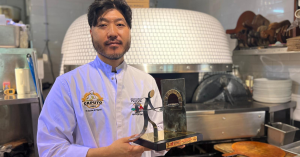Looking up the term ‘pizza’ on the Italian dictionary, its nature as a feminine noun immediately springs to mind.
Pizza is woman
To understand what is meant in Naples when people say ‘a pizz è femmena’, we have with us the very talented Jessica De Vivo, pizza maker and owner of the pizzeria MaryRose:
“First of all, I would like to extend a warm greeting to all Initaly readers.
The fact that pizza is “femmena” (female) is confirmed by its etymology: among the various determinative articles, we use “LA”.
Precisely because pizza is ‘femmena’, I decided to embark on this path of mine at the age of just 7 and now I can say that I am really proud of what I do.I am a little sorry that the number of female pizza makers is not in proportion with the number of male pizza makers. I think the number of us women could grow much more.
This year, women triumphed at the Pizza Village at the Caputo World Championship, with the victory of Madoka Shibamoto from Japan, in the contemporary pizza category. So I think we know how to do very well, and I am very happy about that.
Undoubtedly, women also have much more elegance in the preparation of pizza.”
What does pizza represent for Neapolitans?
For us Neapolitans, pizza is life, there could be many initiatives dedicated to the many Neapolitan products of excellence, but it is no coincidence that the ‘Pizza Village‘ is held every year, in honour of our delicacy, which is appreciated all over the world.
Is this Asian success at the Caputo World Championships marketing, in your opinion, as pizza reaches further frontiers, or can skill and mastery belong to everyone?
Look, I think it’s possible that mastery can belong to everyone and, why not, even to the Asian winners.
The only thing that I believe is indispensable, both in the preparation of contemporary pizzas and traditional (STG) ones, is that one must always follow Neapolitan dictates, this I believe is the number one rule for this type of craft.

As of 2017, we can see that pizza and ‘the art of the Neapolitan pizzaiolo’ has been recognised by Unesco and inscribed on the list of the ‘intangible heritage of humanity’.
Already in 2010, however, the European Union Commission passed a regulation governing the production of Neapolitan pizza worldwide, officially recognising it as a TSG, a mark of origin that stands for Traditional Speciality Guaranteed, used to protect certain typical products whose preparation requires precise production methods.
Precisely for this reason, the Caputo World Championship is held every year (now in its 20th edition).
The three-day competition is organised by the Associazione Pizzaiuoli Napoletani, chaired by Sergio Miccù.
This championship sees the participation of around five hundred pizzaiuoli from all over the world, who want to win the title of world champion at all costs.
The Caputo Cup is an opportunity for sharing, but above all a chance to challenge all the world delegations present, since, thanks to Caputo importers, hundreds of Caputo Cups are held around the world every year.
This year, about one in three participants was foreign. This manifests and demonstrates once again that Neapolitan pizza, as well as the art of the pizzaiuolo, no longer has any geographical boundaries, becoming perhaps the most loved dish all over the world.
This was also possible as people came out of the pandemic and returned to travelling.
There were also many emotions in the stands, between the adrenaline for the competitions and the great desire to have fun, comparing techniques and ingredients.

There was great participation and excellent results from the Asian continent, which brought the beauty of 40 Korean, 21 Japanese and 26 Chinese and Taiwanese pizza makers to the competition.
Also important is the presence of the pink quota, which this year reached almost 10% of the total with about 40 “pizzaiuole” competing.
There was also great participation from the American continent. As many as 27 competed for the title of Best American Pizza.
Returning to the success of the Asian continent, we can see how Korea and Japan were the undisputed protagonists of this latest Caputo Cup.
For the STG category, Traditional Speciality Guaranteed, the winner was Korean pizza maker Jun Hwan Yu, while for the Contemporary Pizza category, the winner was Japan’s Madoka Shibamoto.

For the other categories, the winners were: Claudio Vicanò (Pizza Classica), Stefano Caiazza (Pizza in teglia), Carmine Argenziano (Pinsa/metro/pala), Daniele Atonna (Seasonal pizza), Nunzio Gallo (Gluten-free pizza), Ivan Celio (Junior pizza), Ciro Magnetti (Fried pizza), Antony Barghela (American pizza), Giorgio Nazir (Acrobatic races-wider pizza), Saverio Labate (Acrobatic races-faster pizza), Giorgio Nazir (Freestyle), Croatia (Nations Trophy), Salvatore Iorio (Red Tomato Trophy).
So, we can undoubtedly say, reiterating the concept of Mulino Caputo’s patron, Antimo Caputo, that the World Pizzaiuolo Championship is a true success, the result of year-round itinerant work.
The Caputo Trophy is the only true world championship, precisely because with its stages, it is able to touch every continent.

